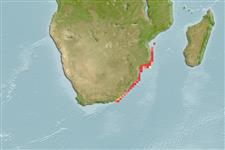Elasmobranchi (squali e razze) (sharks and rays) >
Torpediniformes (Electric rays) >
Narkidae (Sleeper rays)
Etymology: Heteronarce: Greek, heteros = other + Greek, narke = numbness (Ref. 45335).
Eponymy: Dr Samuel Trevor Walton Garman (1843–1927) was an American naturalist, most noted as an ichthyologist and herpetologist. [...] (Ref. 128868), visit book page.
More on author: Regan.
Environment: milieu / climate zone / depth range / distribution range
Ecologia
marino demersale; distribuzione batimetrica 73 - 329 m (Ref. 6589). Subtropical; 20°S - 35°S, 27°E - 37°E (Ref. 114953)
Western Indian Ocean: southern Mozambique to Algoa Bay, South Africa (Ref. 5578).
Size / Peso / Age
Maturity: Lm ? range ? - ? cm
Max length : 25.0 cm TL maschio/sesso non determinato; (Ref. 6589)
Short description
Chiavi di identificazione | Morfologia | Morfometria
Small ray with an elongated, narrow disc and a small, narrow caudal fin (Ref. 5578). Plain brown above, white below (Ref. 5578).
Found on the outer shelf and upper slope (Ref. 5578). Life history unknown. Males reaches maturity at ca. 17 cm TL (Ref. 114953).
Life cycle and mating behavior
Maturità | Riproduzione | Deposizione | Uova | Fecundity | Larve
Compagno, L.J.V., 1986. Narkidae. p. 113-114. In M.M. Smith and P.C. Heemstra (eds.) Smiths' sea fishes. Springer-Verlag, Berlin. (Ref. 6589)
IUCN Red List Status (Ref. 130435: Version 2024-1)
Human uses
Pesca: di nessun interesse
Strumenti
Special reports
Download XML
Fonti Internet
Estimates based on models
Preferred temperature (Ref.
123201): 15.2 - 22, mean 18.1 °C (based on 27 cells).
Phylogenetic diversity index (Ref.
82804): PD
50 = 0.5627 [Uniqueness, from 0.5 = low to 2.0 = high].
Bayesian length-weight: a=0.01000 (0.00244 - 0.04107), b=3.04 (2.81 - 3.27), in cm total length, based on all LWR estimates for this body shape (Ref.
93245).
Trophic level (Ref.
69278): 3.2 ±0.3 se; based on size and trophs of closest relatives
Resilienza (Ref.
120179): Basso, tempo minimo di raddoppiamento della popolazione 4.5 - 14 anni (Assuming fecundity<100).
Fishing Vulnerability (Ref.
59153): Low vulnerability (15 of 100).
